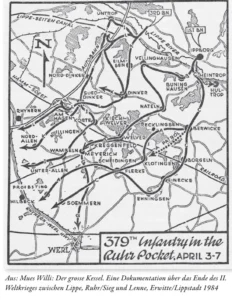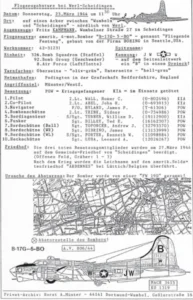In the spring of 1945, 80 years ago, American combat troops advanced into central Westphalia, entering Scheidingen on April 7th.

The parish chronicle of St. Peter and Paul describes this period: “Like a dangerous snake, the wave of war crept closer.” Weeks before Easter, signs of the approaching conflict were evident: groups of forced laborers and prisoners of war, emaciated and lice-infested, were led through the village.
Increased air raids targeted nearby cities, and the railway line between Scheidingen and Wambeln became a focus for low-flying aircraft. A year earlier, an American “Flying Fortress” bomber, en route to Münster, crashed in a field near Scheidingen.

The villagers awaited the “enemy” with mixed feelings, uncertain whether they would act as occupiers or liberators. After Easter, on the day before „White Sunday“, the war reached Scheidingen with a loud bang. A U.S. tank hit a mine near the Zollbrücke over the Salzbach and fired towards the village. Ground troops then searched homes for German soldiers; although regular Wehrmacht units had left, some stragglers had sought refuge in barns the previous day.
Artillery fire resulted in a nine-year-old boy losing his right leg. The Americans established their command post in a building now used as a hair salon, remaining there for about six weeks. Wristwatches were particularly coveted by the GIs, leading to their nickname as the “watch-collecting army” (Uhren-Sammler-Armee = USA). Conversely, village children received sweets and chocolate from the soldiers. Overall, Scheidingen endured the occupation relatively unscathed, whereas neighboring Illingen suffered multiple casualties and injuries. The fate of those who fell into the hands of the Red Army in the East was even more severe.
Prior to this, U.S. troops had occupied Welver. According to the parish chronicle, the “Volkssturm” was ordered to erect tank barriers at the village exits, a directive from the NSDAP local group in Welver, across the Salzbach, colloquially known as “Jordan.” The area around Meyerich station was considered a stronghold of Nazi authorities, with the feared local leader being an early Nazi Party member who had “synchronized” the Scheidingen municipal council, replacing democratic self-governance with the “Führer principle.”
The American arrival shifted power dynamics. Scheidingen’s mayor, a Nazi Party member and chicken farmer by profession, was removed to pave the way for a democratic fresh start. On May 3, 1945, the district administrator appointed new mayors and deputies in agreement with the military government, ensuring they had no Nazi affiliations. Franz Berz (Naarmann) became Scheidingen’s mayor, with Fritz Kampmann (Baule) as his deputy; both were farmers, members of the Catholic Centre Party, and politically untainted. In 1946, the first post-war municipal elections reaffirmed their positions.
However, not all areas experienced change. The village school opposite the church retained its headteacher, a Nazi-affiliated educator from the Ruhr area, who continued teaching despite the regime change.
For the villagers, the war effectively ended with the Americans’ arrival, four weeks before Germany’s unconditional surrender on May 8, 1945. Yet, peace remained elusive. The route from Scheidingen to Werl was nearly impassable, and a local employee was gravely injured on his way home. Former Russian and Polish forced laborers, housed at the Werl airbase, roamed the countryside at night, looting isolated farms like Schulte-Euler, Schulte-Bisping, and Lips in Vöhde. With state authority collapsed and little assistance from occupying forces, local men formed a kind of militia. Tragically, a Polish worker aiding this watch service was mistakenly shot and killed by Allied soldiers during a nighttime operation, having been mistaken for a looter.
These events were consequences of a war initiated by Germany, which returned to devastate its originator. Few families were spared painful losses: fathers and sons killed, missing, or imprisoned; bombed-out refugees from the Ruhr area; packed trains with urban dwellers seeking supplies; and displaced individuals from Silesia, Pomerania or East Prussia mourning their lost homelands.
It’s crucial to remember this dark chapter of German history, including the Holocaust, which claimed members of the Scheidingen-born Schürmann family. Emil, Albert, and Selma were murdered in the Treblinka concentration camp. Eva, married to Max Halle, the last head of the Jewish community in Werl, perished during her deportation on April 30, 1942. In their memory, a path in the “new” settlement was named after the Schürmann family.
History urges us to take responsibility for peaceful coexistence. A life in peace and freedom is not guaranteed; we all can—and must—contribute to its preservation.
Translation of the article „Als die Amerikaner kamen“, published on December 16, 2020)
